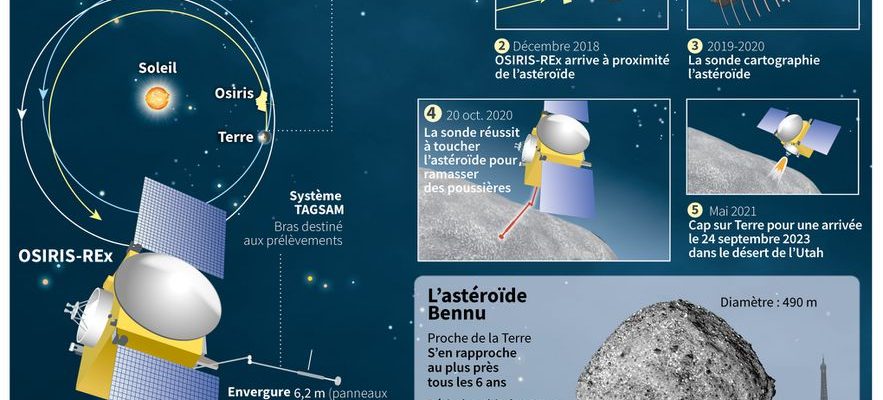The time of science requires patience. After seven years of waiting, scientists will finally discover this Sunday, September 24, the largest asteroid sample ever collected, brought back to earth by the Osiris-Rex probe in the afternoon. After its takeoff in 2016, and a period in orbit around an asteroid of around 500 meters in diameter named Bennu in 2018, the Osiris-Rex probe collected stones and dust there in 2020.
It should, if all goes well, land in the Utah desert this Sunday, on a military zone usually used to test missiles. The final descent through the Earth’s atmosphere promises to be perilous but the American space agency hopes that it will result in a smooth arrival, around 3 p.m. in France and 9 a.m. in the United States.
© / afp.com/Jonathan JACOBSEN, Philippe MOUCHE
History of our origin
Some 250 grams of material should “help us better understand the types of asteroids that could threaten the Earth”, and shed light on “the very beginning of the history of our solar system”, explained the head of the space agency, Bill Nelson. Asteroids are composed of the original materials of the solar system, 4.5 billion years ago. Unlike Earth, they remained intact. They therefore hold “clues about how the solar system formed and evolved,” Melissa Morris, head of the Osiris-Rex program at NASA, said at a press conference. “It is the story of our own origin.” Scientists believe the asteroid Bennu is rich in carbon and contains water molecules locked in minerals.
The arrival of this new information thanks to the return of Osiris-Rex is therefore “truly historic”, Amy Simon, a scientist at NASA, told AFP. “This will be the largest sample that we bring back from the lunar rocks” of the Apollo program of 1972. It is the first time that the American agency has managed to carry out such a mission, which had previously only been successful by Japan .
Entry into the atmosphere at 44,000 kilometers/hour
The maneuver to be carried out promises to be dangerous before gaining access to the precious cargo. The probe must release the capsule containing the sample approximately four hours before landing, more than 100,000 kilometers from Earth. During the last 13 minutes, this capsule will therefore cross the atmosphere alone: it will enter at more than 44,000 km/h, with a temperature rising to 2,700°C.
The fall, observed by army sensors, will be slowed by two successive parachutes. It is essential that they deploy correctly to avoid a “hard landing”, in the zone of 58 by 14 kilometers planned to receive it. It could have been decided at the last moment not to release the capsule, if the risk of missing the area was too high: in this scenario, the probe would then have had to circle the Sun before trying its luck again… in 2025. But Around 11 a.m., the Osiris-Rex mission team finally voted to release the capsule towards Earth, according to NASA’s X account (ex-Twitter). The probe should therefore immediately set off for another asteroid named Apophis, which should pass very close to the earth around 2029.
Some precious asteroid dust studied in Nancy
Once the capsule is on the ground, a team equipped with gloves and masks will check its condition, before placing it in a net, then lifted by a helicopter and taken to a temporary “clean room”. The capsule must be exposed to the sand of the American desert for as short a time as possible in order to avoid any contamination of the sample which could distort subsequent analyses. On Monday, it will be flown to the Johnson Space Center in Houston, Texas. This is where the box will be opened, in another airtight room. The process will take days.
The majority of the sample will be preserved for study by future generations, when new technologists allow analyzes still impossible today. About 25% will be immediately used for experiments. A portion of the precious samples will also be sent to selected laboratories. France is one of them: the Nancy Petrographic and Geochemical Research Center should, according to information from Franceinfobenefit from a few milligrams to study gaseous species using a laser which will heat these asteroid grains.
Japan and Canada are also partners. Japan itself gave NASA some grains from the asteroid Ryugu, of which it brought back 5.4 grams in 2020, during the Hayabusa-2 mission. In 2010, he reported a microscopic amount from another asteroid. This time, the Bennu sample is “much bigger, so we will be able to do a lot more analysis,” said Amy Simon. NASA is planning a press conference on October 11 to reveal its first results.
